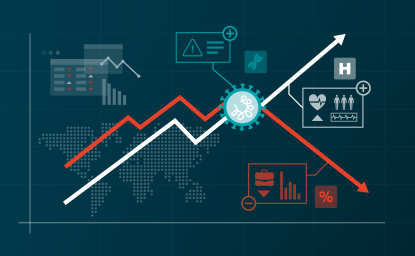The IMF and World Bank spring meetings will be held virtually this week as global policymakers confront the manifold challenges posed by the COVID-19 pandemic. The latest edition of the IMF’s flagship publication, the World Economic Outlook, which was released earlier this week, lays out the economic devastation the crisis is projected to leave in its wake. The Fund now expects the worst global economic contraction since the Great Depression.
Given the size of the economic shock, it is not surprising that policy responses have been nothing short of extraordinary. Governments have implemented a broad range of measures to assist those directly affected by the loss of income and cessation of economic activity and to lay the groundwork for a rapid recovery once social distancing is relaxed and the economy is re-opened. These measures include direct fiscal support, expanded benefits and relaxed eligibility requirements for unemployment benefits, forgivable or partly-forgivable loans, and wholesale regulatory forbearance to relax prudential constraints on bank lending.
As extraordinary as the fiscal and regulatory responses to date have been, they have been more than matched by the actions of central banks. And no central banks have acted more aggressively than the US Federal Reserve and the Bank of Canada. The list of policy actions and new or reactivated credit facilities that the two institutions have adopted is already long. It continues to grow.
It is helpful to think of the responses by the Fed and the Bank of Canada in terms of three phases—corresponding roughly to past, present, and future actions.
The initial phase of their actions reflected the panicked response to the looming crisis as markets incorporated the potential implications of severe social distancing measures, possible disruption to global supply chains, and the collapse of world oil prices. Collapsing asset prices wiped out trillions of dollars of wealth and stoked fears of market dysfunction. In this fraught environment, the focus of the Fed and the Bank of Canada was on ensuring liquidity. Investors rushing to shed risky assets investors sought refuge in the ultimate safe haven in periods of uncertainty. As the old adage puts it, in such times “cash is king.”
Had the two central banks not satisfied this demand for liquidity by accepting a growing list of assets, asset prices would have undoubtedly spiraled further down in a fire-sale equilibrium. Such an outcome would have threatened financial stability in a manner all too reminiscent of the terrifying days following the Lehman Brothers bankruptcy in the autumn of 2008. In this respect, the initial response by the Fed and the Bank of Canada, which accounts for the explosive growth of their balance sheets, reflects central banks’ lender of last resort role. Hopefully, with relative calm restored to financial markets, this initial phase is now behind us.
The present phase of the central banks’ response corresponds to their price stability and full employment objectives. Admittedly, full employment is not the immediate objective in the context of social distancing. And monetary policy responses have not reflected immediate price pressures. But Fed and Bank of Canada interest rate cuts are nevertheless fully consistent with traditional stabilization objectives.
Restoring full employment once social distancing is relaxed would be immeasurably more difficult if the idiosyncratic firm-specific “relationship capital” between firms and workers is destroyed. Preserving these relationships by keeping employees on the payroll entails an investment in human capital, and lower interest rates reduce the cost of those investments.
With those firm-specific relationships intact, the substantial monetary impulse that the two central banks have injected into the U.S. and Canadian economies through rate cuts should fuel recovery when social distancing is relaxed. Absent these cuts, both economies may confront sustained deflationary pressures going forward—the problem may be too little inflation, rather than too much. Given the long and variable lags associated with monetary policy, current monetary policy conditions have to be accommodative to address these future challenges.
Neither the past nor present phase of the central banks’ responses should be particularly problematic from a governance perspective. As noted, the first phase reflects central banking’s quintessential lender of last resort function—albeit consistent with an expansive interpretation of Bagehot’s admonition that central banks, “lend freely, on good collateral at penalty interest rates.” Bagehot, the legendary editor of The Economist, wrote an early, seminal study of central banking. The second phase, meanwhile, is wholly consistent with the Fed’s mandate as legislated by Congress and the Bank of Canada’s operating framework.
The third, and future, phase of the central banking response to the Coronavirus is likely to be more controversial. This phase may not be required, particularly if the first two responses are successful in securing a rapid, robust recovery. But the enormous economic dislocation caused by the crisis has already led to enormous fiscal costs; these costs would be magnified in the event of a possible second wave of infections resulting from a premature relaxing of social distancing measures. Government deficits have exploded and public debt along with them. Going forward, central banks may thus have an added objective of supporting government bond markets thrusted upon them. In effect, this would require an environment of low, stable, long-term interest rates.
For the avoidance of doubt, this added objective does not imply the direct financing of government through money issuance. (Though when interest rates are zero, the distinction between government bonds and money become blurred.) And it does not necessarily mean that central banks will be conflicted in the pursuit of their full employment and price stability objectives. But it does raise the prospect of difficult trade-offs in the absence of a felicitous coincidence among them and the need for low, stable interest rates.
This future response, should it be needed, would not break new ground. Central banks faced similar constraints following the accumulation of massive government debts in the Second World War. Those debts were whittled away thanks to the combination of strong growth, moderate inflation, and low interest rates. The same conjuncture can likewise work to bring debt burdens down over time.






